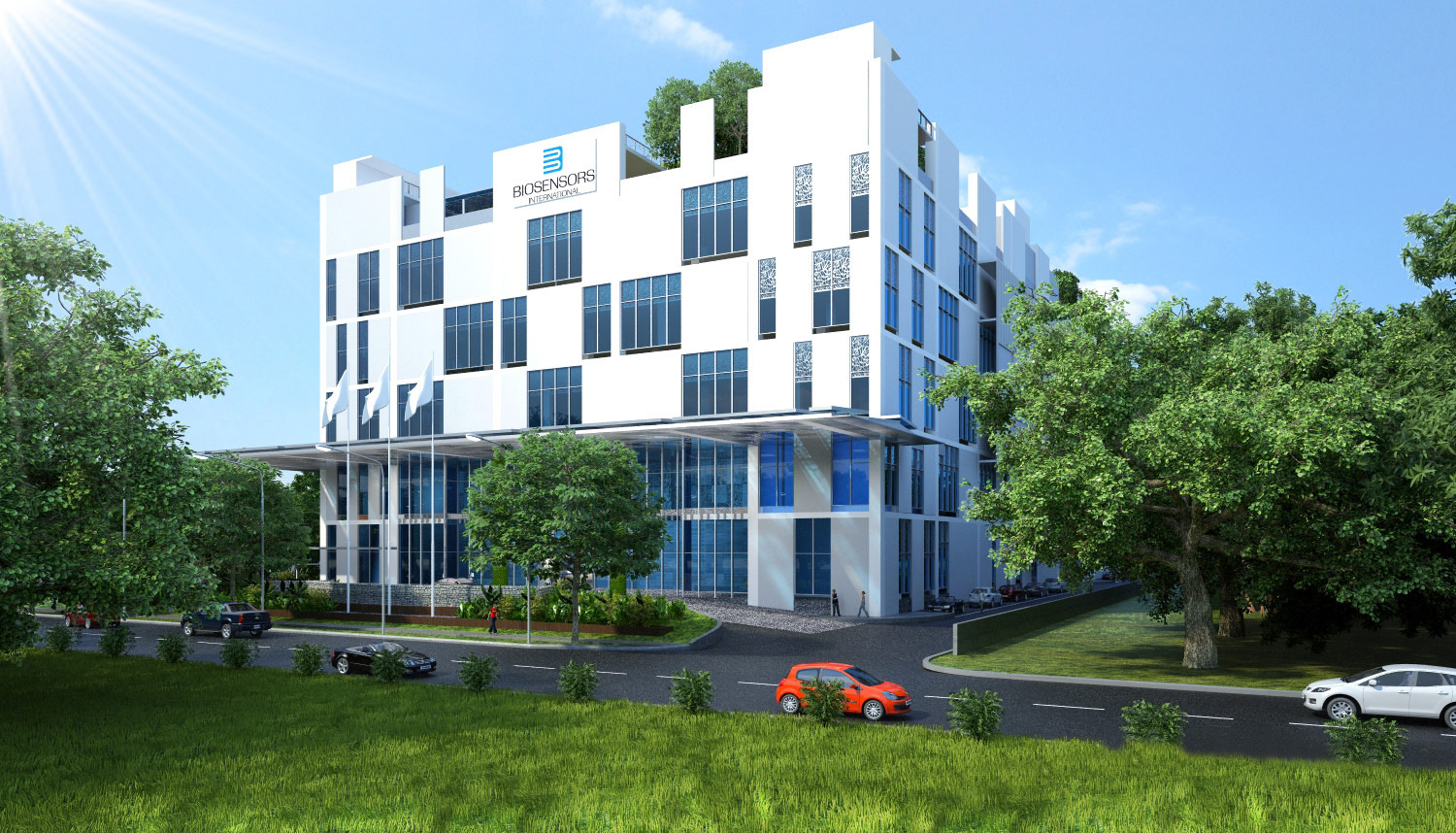Sustainable Clean Room
| Project | Industrial Headquarters and Plant in Jurong, Singapore |
|---|---|
| Client | Biosensors International |
| Date | 2013 |
| Project | Industrial Headquarters and Plant in Jurong, Singapore |
|---|---|
| Client | Biosensors International |
| Date | 2013 |
Design Brief
The brief called for a 6 storey, 30000m2 sustainable manufacturing plant and headquarters of Biosensors International – a research and development firm that produces cardiovascular stents (expanded wire tubes implanted into blood vessels to ease blood flow). It is one of the largest manufacturers and suppliers of this medical technology in the world.
Located in the Jurong industrial area of Singapore, the building required clean rooms, laboratories, storage facilities as well as offices and meeting rooms within a large floor plate of approximately 115m by 53m, the equivalent of 4 Olympic-sized swimming pools.
“We created an architectural concept that shares the same restorative quality of stents to combat heart diseases and to prolong lives.”
Design Concept
We worked closely with the client’s project management team to achieve highly functional and operational space planning requirements unique to their business. Internally, the building was a large big-box facility that needed to accommodate their complex manufacturing processes. Due to the large building footprint, we were aware that the interior spaces and workers would be perpetually in the dark. We therefore decided to approach the architecture as a vessel that had the same restorative qualities as the stent.
By studying the properties of stents, we created an architectural concept that shares the same restorative quality of stents to combat heart diseases and to prolong lives.
The building elevations are analogous to stents whereby large openings introduce daylight into the deepest zones from all sides. In some openings, they also permit natural ventilation. Permeating through the façade, these openings gradually transition from large windows into wire mesh screens that filter light into the deep interiors, thereby saving energy costs on artificial lighting.
The public corporate spaces are designed with a minimalist material palette to reflect the client’s ethos of hygiene, precision and innovation. Carefully curated swathes of glass, stone and perforated mesh are applied throughout the offices and mezzanine areas. They work together to create a cohesive tapestry of opaque and light-filtering elements befitting a world-class research facility.
At the top executive floor, a series of roof gardens and lawns are interspersed with courtyards for natural light and rainwater collection. Solar panels cover the topmost roof to store solar energy that power the offices and equipment.
The end result was a medical headquarter that used forward-looking principles and state-of-the-art technology to create a distinct statement about sustainability in the tropics. From this technologically progressive facility, Winstudio gained a deeper knowledge and experience about the design of sustainable industrial buildings. Familiarity with such keystone projects enabled our architects to create sound and rational design solutions even for complex design typologies.






| Project | Industrial Headquarters and Plant in Jurong, Singapore |
|---|---|
| Client | Biosensors International |
| Date | 2013 |






Design Brief
The brief called for a 6-storey, 30000m2 sustainable manufacturing plant and headquarters of Biosensors International – a research and development firm that produces cardiovascular stents (expanded wire tubes implanted into blood vessels to ease blood flow). It is one of the largest manufacturers and suppliers of this medical technology in the world.
Located in the Jurong industrial area of Singapore, the building required clean rooms, laboratories, storage facilities as well as offices and meeting rooms within a large floor plate of approximately 115m by 53m, the equivalent of 4 Olympic-sized swimming pools.
Design Concept
We worked closely with the client’s project management team to achieve highly functional and operational space planning requirements unique to their business. Internally, the building was a large big-box facility that needed to accommodate their complex manufacturing processes. Due to the large building footprint, we were aware that the interior spaces and workers would be perpetually in the dark. We therefore decided to approach the architecture as a vessel that had the same restorative qualities as the stent.
By studying the properties of stents, we created an architectural concept that represents the ability of stents to combat heart diseases and to prolong lives.
The building elevations are analogous to stents whereby large openings introduce daylight into the deepest zones from all sides. In some openings, they also permit natural ventilation. Permeating through the façade, these openings gradually transition from large windows into wire mesh screens that filter light into the deep interiors, thereby saving energy costs on artificial lighting.
The public corporate spaces are designed with a minimalist material palette to reflect the client’s ethos of hygiene, precision and innovation. Carefully curated swathes of glass, stone and perforated mesh are applied throughout the offices and mezzanine areas. They work together to create a cohesive tapestry of opaque and light-filtering elements befitting a world-class research facility.
At the top executive floor, a series of roof gardens and lawns are interspersed with courtyards for natural light and rainwater collection. Solar panels cover the topmost roof to store solar energy that power the offices and equipment.
The end result was a medical headquarter that used forward-looking principles and state-of-the-art technology to create a distinct statement about sustainability in the tropics. From this technologically innovative facility, Winstudio gained a deeper knowledge and experience about the design of sustainable industrial buildings. Familiarity with such keystone projects enabled our architects to fashion sound and rational design solutions even for complex design typologies.